Grubering the Skillets
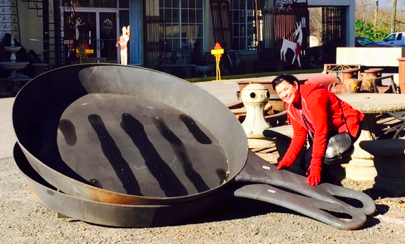

I am not going to gruber you this morning about cast iron. I am sure you have heard the new verb “gruber,” (as in: “to mendacious lie about major policy issues affecting all Americans because you have contempt for their intelligence,” and “an erroneous and inflated assumption of superiority and enlightenment totally in conflict with simple facts.”)
Rather, I will just lay out some key observations. I am not going to take action to ensure all Americans have cast iron, even if it is the right thing to do.
I got a case of serious skillet envy for the Black Dog Salvage concern out in Strasburg, VA, where my squadron buddy Bronco spotted the most amazing nested skillets ever at the Black Dog Salvage concern.
Strasburg is where the cursed I-66 interstate is born, and from which it sweeps majestically into the log-jam of the DC sprawl.
My pal Bronco and his lovely wife Lynn were out there prowling antique stores. I share the affliction- like I need any more junk. My garage at the farm already looks like a much more chaotic mini-version of the Strasburg Antique Mall.

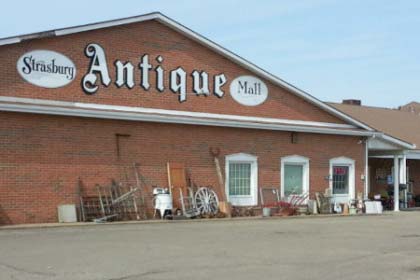
Bronco knows my weakness for cast iron cookware, and he was tweaking me with phone-cam pictures about some of the treasures he observed.
A couple key points. I was going to do an exploration of some of the myths surrounding cast iron a while ago, but I will summarize a much longer appreciation of some common myths:
1. 1. These are not fragile things. You can use them as hammers if necessary.
2. 2. Cast iron is great about retaining heat- but it can have hot spots. Know your burner. It is your friend as much as the skillet.
3. 3. Don’t worry about chipping the seasoned finish. The residue is chemically annealed to the surface. If you scratch it, just re-season with a couple tablespoons of fresh extra virgin olive oil- or your favorite with a high burning point.
4. 4. Some claim that you should keep soap away from them. Point 2 above refers.
5. 5. I ignore that recommendation and re-season with each use with a small amount oil to dry the skillet and keep the seasoning fresh.
6. 6. Older cast iron is better because the casting techniques were more precise, but the new stuff from Lodge is just fine.
There. I feel better.


Skillets from different time periods can command significantly higher prices than modern ones. See point 6 above. These are collectible items so there are some runs of certain markings: the gold standard is the products of the Griswold company with the “slant logo” or “spider web” are more valuable due to their relative scarcity. If you want a good cooking Griswold buy a flat example that has “Erie, Pa.” stamped anywhere on the bottom and you cooking with gas.
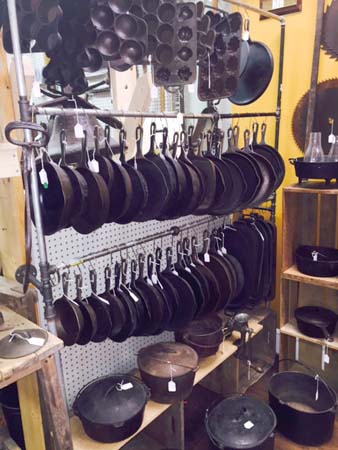
(Heaven in Booth 21 at the SAM. Dutch ovens, skillets of all sizes, those cool cornbread muffin bakers and hard to find lids, a feature I find absolutely essential for slow cooking).
Note that some vintage cast-iron pieces (including some, but not all, Griswolds) have raised “heat rings” on the bottom. I’ve found that a certain size of heat ring just isn’t compatible with the burner grates on my gas stove, which are configured sort of like a ship’s wheel. When the pot is centered on the burner, the heat ring is balanced on the outermost points of the spokes, so the pot easily slips off the grate and sits at an angle.
That was the problem with a Griswold #12 that a friend had- I don’t know if the chicken fryer-model with the small handle opposite the big one all had them. I dunno. I will check the ones at the Strasburg Antique Mall when I get out there.


(Bronco claims to even have found some examples of the elusive and coveted Griswold Model #3 & #5).
Ann is the weekend Concierge at Big Pink. I stopped to check the mail yesterday and she smiled as she produced two slick magazines filled with hundreds of recipes for cast iron cooking. She is going to pass them along when she is done reviewing them. That, and a great recipe for one-inch pork chops that has been embargoed by the correspondent until I actually take it for a test-drive. I am going to swing by Croftburn Farms and pick some up and do and try it for dinner.
And maybe wander through the Minuteman Antiques Mall and see if there is a Griswold #12 hanging out there.
Copyright 2014 Vic Socotra
www.vicsocotra.com
Twitter: @jayare303
Nice
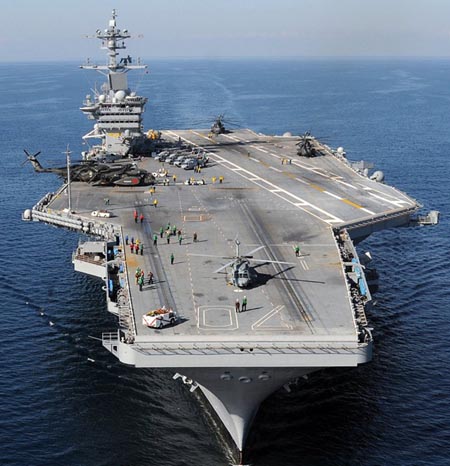
I had just got to the thrilling conclusion of time with the redoubtable Matre Avery-Glis Kaine. We were swapping sea stories, and we had all made calls in the south of France, at Toulon, Marseilles, Nice and Cannes. They are all connected by frequent rail, and you can get all the way to Monaco in a morning.
My pal Point Loma leaned over at the bar at Willow and whispered, sotto vocce, “It is not a Tres Grand Voiture, he said. That means a big-ass automobile. The high speed train is called the TGV- the Train a Grand Vitasse, you dumbass.”
“Well, it was a goddamn big car. But I take your point.”
Point Loma laughed. “My initiation to the City of Light was in 1983 on the USS Carl Vinson (CVN-70) during her round-the-world delivery cruise from Norfolk to Alameda. We had ducked into the Med on the first part of our nine-month extravaganza for some weird nuclear response reason on the way to four months on Gonzo Station in the IO.”
“I was responsible for planning the Boat 1 target package on Forrestal. Problem was there was no Boat 2 around to do the rest. It is sort of embarrassing to have the wrong strike package all planned.”
“I’am surprised they didn’t crucify you for that,” he said, taking a sip of Happy Hour White.
“Trust me, they tried. But I had the message from EUCOM directing me what to do. They fucked up.”
“Never trust the staff of a Combatant Command,” he said. “I learned that the hard way. We could have gone to Cannes, but the luck of the port schedule was that the boat was going to be on the hook for eight days in Nice which, considering the fact that it was the off-season there on the Cote D’Azure (March), made it even weirder than the other port calls we had in the Atlantic on the way south around Africa – Casablanca and Abidjian.”
“One of my bunkroom mates was the famous Harry O, who was from Georgia and one of our finer A-6 ball flyers. Harry O’s family was from Kentucky and were original investors in Harlan Sander’s fried chicken enterprise. To his credit, he lived off of his Naval aviator’s salary which was a lot more than I made as a air intelligence LTJG on a second cruise, but I had to keep up.”
“Of course,” I said. “One must keep up appearances.” Sammy the Moroccan bartender topped up my glass. He keeps pouring and I keep tipping, so things work out.
“Harry O never cared to hang out in the admin in port and, like me, wanted to see places. His unofficial motto was “I’m going to have fun and I don’t care what it costs. Signed, Harry O.””
“Four hours after the Vinson anchored in Nice, we were on an Air France flight to Paris, and were delivered from Charles de Gaul airport via bus to l’hopital on the Rive Gauche. We found a hotel, had a fabulous three days, and took the Tres Grand Vitasse south to Geneva.”


“I never got out of the airport there when I stopped coming back from Zagreb,” I said pensively. “I have always wanted to see the place. I had to be content with airport chocolate and a couple drinks.”
“After touring around that lovely Swiss city for day, we took a slower train back around the Alps to Nice. We had reserved seats but hung out in the bar car and met some ex-pat twenty-something American female dental techs who were working in Switzerland who were making a group trip down to the Cote d’Azur.”
“Go figure that there would be a community of American dental techs in Europe,” I said. “I met a bunch of Americans- kids who grew up on the Army bases. There were a couple of then who had never actually been to America. Their Dads homesteaded in Germany and liked it.”
“Yeah. Never see that again. The world has changed. But you can imagine our reception at the staff admin suit back in Nice when we walked in the door with six very cute gals in tow, four extras for the boys with three days to go in port.”
“As part of the deal, they had a nice trip out to visit the ship and by then, it had warmed up enough to go to the beach.”
“We saw topless gals there in the middle of winter. It was very progressive.”

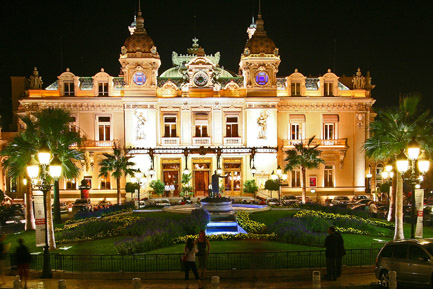
Point Loma nodded. “One night, I remember vividly wearing my dark grey James Bond suit I that was tailored for me at Harilelas in Hong Kong during the 1981 cruise on the Hawk on a visit to the casino in Monte Carlo. I took my date, a very nice brunette gal from Connecticut with spectacular breasts who had gone out with her girlfriends during the day and bought a slinky cream-colored man-killer dress for the occasion.”
“Monte Carlo was a gas, and an easy train ride from Cannes and Nice. The yachts in the harbor had helo decks and were as big as destroyer escorts.”
Point Loma nodded. “We had dinner at a nice place on the hill next to the Casino before going into the Casino. Once inside, we played roulette, rolled the bones at the one lonely craps table (Europeans don’t play craps), and danced together romantically in the disco. Since I was well-dressed, was know to have won some money, and having some true eye candy on my arm, we passed muster for entrance into the adult gaming room, where the minimum bet was 5000 francs. The games there were roulette and baccarat.”
“We watched a very drunk and arrogant Italian playboy lose more money in five rounds of chemin de fer than I had ever made in my life to that point. I can still see the sweat on his face, going mano a mano with this French guy who controlled the shoe. he was kicking this Italian guy’s ass and smiling at him the entire time, which pissed The Italian off even more. As in the movies, the tension around the table was real.”
“I’ll bet. I saw a table in Tombstone Arizona one time where a guy dropped $180,000 on one hand of Faro.”

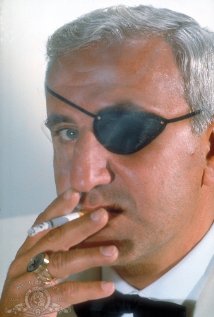
“This guy was bigger than that. Like Largo in the James Bond movie Thunderball, he kept calling “banco” after every game, trying to win his money back. I estimated that he was down something like 300,000 dollars when we left. I realized that I was half drunk in a place way over my head, and that the best thing to do was to hail a cab take my by then very randy girlfriend back to the hotel for the night. After that port call, we had a saying – “Nice was nice.”
Point Loma finished his glass and waved languidly for another. For some reason, all of us at the Amen Corner were smiling. Maybe tomorrow I can tell you about Paris.
Copyright 2014 Vic and Marc
www.vicsocotra.com
Twitter: @jayare303
Tres Grand Voiture
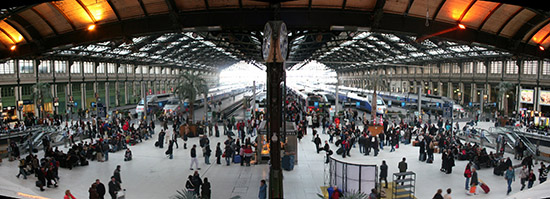
26 DEC 1989: I am up early to organize for the trip to Paris. I wander down to the ship’s Disbursing office and turn a semi-worthless check into a couple thousand francs. I pack my bag, to include formal wear, for the journey to Paris. I have pain et brie frommage for the journey. I have to rouse the Lutt-homme to pass down information on the Campaign Plan to cement victory in the Mediterranean, should we be commanded to enact it.
I pile into the Staff car with Mark and Moose. Mark is going to chauffeur me to the train station and Moose out to the airport to greet his wife Paula who is flying in from America. We drive through Marseilles and get stuck in the massive jam that goes along with the annual France to Ivory Coast cross-country road race.
The crowds are horrendous. Suppose I don’t get on the train? There is a vast throng of Frogs inside the station and on the platforms. I start to get apprehensive about getting where I need to be…Trouble at the ticket window…There are no reservations possible today, Monsieur….”
“Yike!” I say in fluent French. “Well, sell me a ticket anyway. “Maybe I can ride in the bar car……and so began Altogether New Adventures on the TGV….The Tres Grand Voiture high speed train is a thing of wonder. Bullet shaped, it is the railroad from Tomorrowland. I sneak into the bar-car and stake out a place with my New York Times to hide behind. It is a long four-hour ride in the bar car as I anxiously await the moment when the conductor will bust me. When the awful moment comes I use the American defense:
“Pardon, Monsieur, je suis Americain.”
The conductor goes away and I am not fined (which I later discover I should have been) nor am I thrown off the train. The 200KM scenery is spectacular as we roll across the green fields of central France. The sunset highlights the chateaus and villages that dot the landscape, and which slide by at incredible pace.

I alternate between gazing out the window and the New York Times. I actually finish the paper for a change. Darkness and the approach to Paris…I debark in the Gare de Lyon with the usual big city disorientation….I haven’t a clue as to where I am going and the darkness isn’t helping matters a bit. My map is suitable for urban house-to-house fighting, but the detail is too small to find where I am going.
I bite the bullet and do what I normally do when I am hopelessly lost. I hailed a cab. After some initial language problems (I have the name of the hotel spelled wrong) I am hurtling through the streets en route the Hotel de Morny….it is pure Gallic madness as we careen through the Place de Bastille, where I am convinced my driver should be confined, if it were still there.
My driver is an Arab with the clear idea that his martyrdom will translate him immediately to paradise. I am not laboring under the same delusion and my knuckles get white as we swerve around pedestrians…My terror begins to subside as we arrive alive in the Rue Liege to find a modest, but fabulously expensive, hotel.
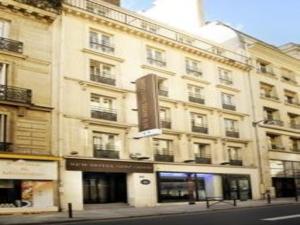
The elevator is slightly smaller than a shoebox and I don’t quite get stuck with my bag. The room is quiet and clean and has double beds. I turn on French TV and the gentle babble in the background is soothing as I sit with my charts and guidebooks. Having safely negotiated the first portion of the odyssey I feel a wave of agoraphobia coming over me, but beat it down.
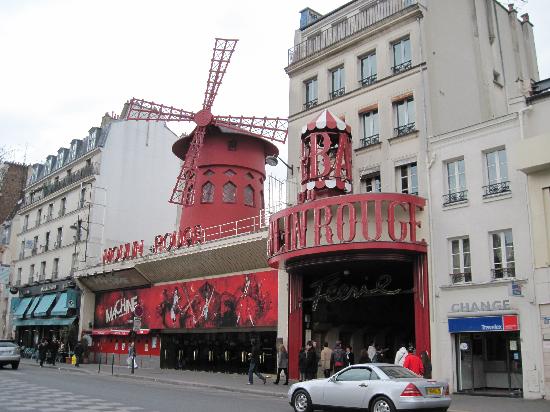
Paris is out there waiting. I get directions to the Metro from the woman at the front desk and then sortie to the streets. I discover I am located just around the corner from the 42nd street of Paris; the Moulin Rouge is three block away, just up from the Place Pigalle. The red windmill is incongruous among the sex shops.
Hawkers prowl the pavement in front of their establishments, pawing at me as I walk along. I see a very tall gang of transvestites, surrounded by an admiring group of short Oriental males. The weirdness quotient is very high. I have a beer at a little standup bar and decide it would be easier to just get a bottle of Schweppes Dry to pour some vodka in and go to bed. I think this is going to be an adventure of unprecedented proportions.
Copyright 2014 Vic Socotra
www.vicsocotra.com
Twitter: @jayare303
Guests at the Wedding
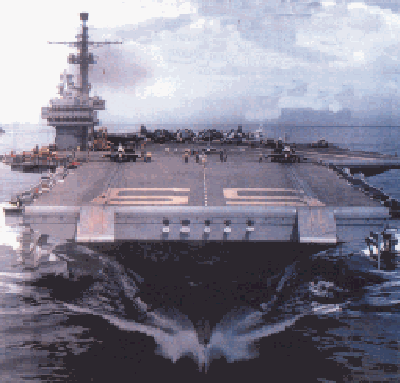
20 DEC, 1989:
There was a great Foc’sle Follies the last night at sea before pulling in to Marseilles on the mighty USS Forrestal, (CV-59). The Follies are the satiric variety review the Air Wing puts on for itself to poke fun at the complexities of life on the Bounding Main with 4,000 of your closest friends, armed to the teeth. There was much merriment at the expense of Oz, the Air Boss, and much mirth at the Vice Admiral who flew aboard to take our operational briefing. Of particular note was the dark edict of three days ago which forbad the mention- or even skeptical look- at the admiral’s at-sea toupee. Ops O meeting this morning at 0900; I awoke with a headache from the post-follies follies.
Staff meeting followed the Ops meeting…mostly about not letting important things fall through the crack during our nearly month-long port visit. After the President visited us to meet with Mr. Gorbachev at Malta, we are supposed to be low-trifle and non-threatening to USSR’s interests in the Mediterranean. Our Ops Officer Scooter and other notables (such as the Monsterchief) are going back to Florida for Christmas. I’m not.
At lunch, the last meal to be served in Wardroom One until we go to sea again I ordered a chili-burger and tried to fend off questions about the why, exactly, the U.S. had declared war on Panama. I had not been consulted on the matter and didn’t understand what it was all about, although I bluffed fairly well until afternoon, up to my elbows in Campaign documents with France calling me from the distance.
I quoted Presidential Spokeman Marlin Fitzwater who said at an emergency press conference at 0140 Washington time:”The President has directed United States Forces to execute pre-planned missions in Panama to protect American lives, restore the democratic process, preserve the integrity of the Panama Canal treaty and apprehend Manuel Noriega.
“Heavy fighting reported in Panama.” Goddammit, I’m in the wrong Theatre again!
Later, we stomp down the Officer’s Brow to go ashore in France. We are waiting in a long line of sailors for a bus to get out of the port area. For security, we are located way out in the sticks. In some ways this is worse than being at anchor. Suddenly our friends from the Flag Staff appeared and our problems were solved. We piled into a tall Mitsubishi van with Spanky M at the wheel and we were free and on our way to actual France!
Spanky has already made a familiarization (“Fam”) hop into Marseilles, so we are not flying blind. We rocket out of the customs/douane area and onto a strange elevated freeway. A cathedral on a hill beckons in the distance and rows of fin de ciecle apartments parallel the expressway.
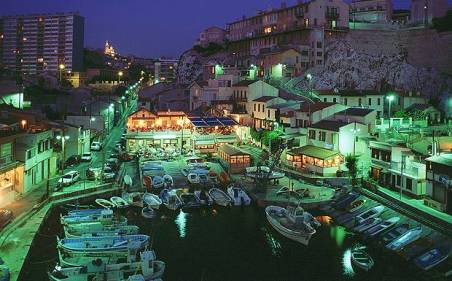
Marseille’s port area sprawls for miles to our right as we roll south into town. We miss a sign or two and motor into the Vieux Port area through the old fortifications. We are immediately into a traffic jam and the urge to park the car is virtually overwhelming. We see an arrow that points to what could very well be a garage and Spanky bolts for it.
It is underground and the ramp is steep. The van is tall. The van does not fit. We are fortunate to escape. We dismount and wander the streets and wind up at an outdoor cafe with our crazy waiter with the Art Garfunkle hair. He likes my French accent. I am nearly totally immersed in the language by the time we finish the first five beers.
We pub crawl through the Gut and enjoy pizzas and artichokes in the Vieux Port. Later, more gratuitous beers at the Bistro New York where CDR Shake holds court with several Bulls of my acquaintance. Shakey graciously “gives me another chance.”
I resist the sudden severe visceral urge to punch him out and walk away in to the night avec my LTJG wingman Josh. Best decision in a long time.
In bed via the last bus by 0330. Liberty- and France- are very good indeed.
21 DEC:
Prepare for the Big Brief. Work aboard ship until 1500. Jog on the pier. Go to France again. What a country! The Christmas shoppers, the beautiful women, the sidewalk cafes. My seeing-eye LTJG Josh and I roam to the outskirts of the city, finding little frommageries and boucheries. We enjoy pressed saucisse sandwiches and have an early night in. Bed by 1100.
As we sleep, a sailor from VS-28 is murdered in town by druggies in the small hours, around 0300. It appears to be a sort of French drive-by killing and not associated with international terrorism.
The Senior Shore Patrol Officer watches him die in the ambulance. Two down on the Cruise so far. Paperwork to follow….
22 Dec:
Big Brief morning. We drink coffee in Mission Planning and make the final tweaks on the brief preparations. I’m in the head reading Navy Times when the summons comes from TFCC. We are on stage at 1050. Admiral Sweetpea, being the Liberty conscious sailor that he is, pronounces his favor and congratulations in a record 42.5 minutes.
Literally floating on air, we drift across the passageway to Admin, where CAG announces the big procession to the Wedding in Cannes. The response among the Junior Officers to the invitation is lukewarm at best.
I am appalled. I shout for support, rallying my staffmates like John Belushi in the rousing conclusion to Animal House. This is an issue of free travel, free food, and the opportunity for total immersion! I convince Toad and Lutt-man that this could be our chance to act as Ambassadors of Good Will to an entire city of helpless French.
New Chop and Thorn T are also bludgeoned into the trip. We pack on the fly, clothes hurtling everywhere through the compartment. Later, in the rental cars, Toad conducts a driving clinic.
Staying on the bumper of the CAG- acknowledged as the world’s greatest attack pilot- who is also lost in France is not the easiest thing to do. Thankfully, we are riding with the Greatest Fighter Pilot of his time, the famous Mr. Toad.
CAG pulls one six G maneuver to get to another lane that is truly a thing of wonder. We wind up on the Superhighway to the Cote d’Azure, after many travails, and roll across the lovely hills of the South of France.
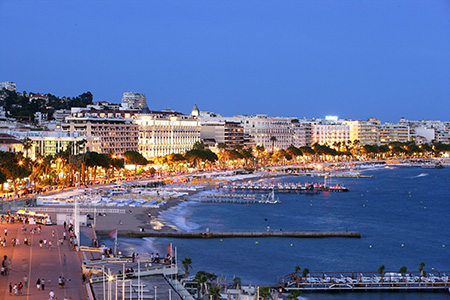
After about three hours we pull off on the Cannes exit and plunge down a long straight road and into the lovely village. We enjoyed the view from the elevated highway which crosses the train station and parallels the commercial district. Later, after a Riviera version of gridlock, we found ourselves ramming the cars into the curb before a quaint walled villa. CAG gets us buzzed through the gate and we walk across a crushed rock driveway and up to the cool dark central staircase that lead up four floors. The place is wonderfully French; obviously vastly expensive but slightly down at the heels.
On the third floor landing we meet the vivacious Avery, the belle Maitre dan les Ville Cannes. She is an erstwhile Baltimorian, practitioner at the French Bar and President and Founder of the Cannes Navy League. Dark haired, Avery is a gamin of indeterminate age; when she laughs, which is often, the wrinkles around her eyes are pronounced.
The laughter begins almost immediately. When you join one of Avery’s parties there is no question that she is in complete command. Within minutes of our arrival we found ourselves shown through the garret apartment that would be our home off and on throughout our month in
France.
We reach the top floor via a narrow staircase; the garret is everything one could possibly ask for. It is a complete apartment with a large central room where you could stand upright under the peak of the roof and a variety of smaller rooms near the eaves where you could not. In the small toilette there is a skylight through which my head potruded while urinating. There was a kitchenette and a magnificent view of the town from a window with working shutters. There is beer in the refrigerator and it is a good thing.
We had pressing social obligations; within the hour we were attired in Service Dress Blues and proceeding in a line like Avery’s ducklings down the narrow streets through the town to the Church. We are among the first of the guests to arrive at the old grey Protestant church and we are seated on the Groom’s side, fashionably down front.
Our role is to provide moral support for him, as he will tie the knot in his LCDR uniform. Avery thinks it will be nice or the Fleet to make a show and thus we are de facto members of the groom’s party, a ship-driver (Blackshoe) we have not previously met. We are the ersatz Groomsmen, guests at the wedding. In French, no less. It is a thing of wonder.
After the service, of which I understand perhaps 30%, we retired to Avery’s to prepare for the Reception, which is to be held in Grasse, France’s largest City. It must be. When we were lost we must have passed about twenty exit signs for the place. Grasse is famous largely for its parfumeries and number of highway exits.
We wind up the long hills and pull into the parking lot of a pleasantly modern hotel where the festivities will commence. We are seated at random throughout the real wedding guests. There is bottomless wine and delicious food. Soon we are dancing and the singing went on until dawn.
I propose a toast and sing my version of the Wedding Song from the Three Penny Opera. The groom seems dazed by the whole thing but we are truly Ambassador’s of Good Will and I am elevated to hero status.
The French are loving our act. Avery makes us promise to come back, and we volunteer to act as her culinary staff for the Christmas Festivities. Later, in the darkness of the garret, we find a recumbent ENS in my designated bed. “Are there any Ensigns in the LCDR’s room?” shouted Lutt-man. Our new Porkchop feigned unconsciousness and I racked in the double bed by the window with Lutt-man.
It is crisp with the window open and the stars are hard, clear lights in the French velvet sky.
Nothing untoward occurred. Not that there is anything wrong with it, of course.
Copyright 2014 Vic Socotra
www.vicsocotra.com
Twitter: @jayare303
The Iron Duke
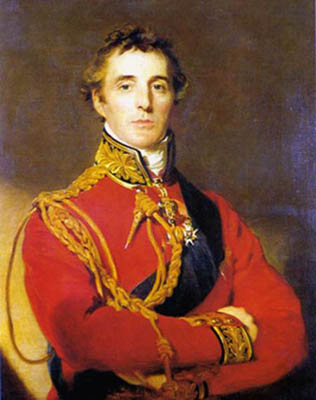
(The Iron Duke- Field Marshal Arthur Wellesley, 1st Duke of Wellington, KG, GCB, GCH, PC, FRS gives us an imperious look. I have to tell you, I have enjoyed taking a trip back in time to visit some of the great cities of Asia from a long time ago. Since I threw in a trip report about the war in the Balkans, I thought I might open the aperture and account for a lost weekend in London, on a mission to confer with our opposite numbers in the UK’s MoD).
After a shivering return from Portobello Road I surveyed my situation from Room 531, Churchill Hotel, Portman Square, London. The sky outside still shed its liquid burden. My London Fog raincoat was in the sink with the hair dryer tucked under it. The hot air forced it up into a tent. I longed to climb back under the covers and doze the afternoon away, but this was the last day in London. I glanced in the London Guide for inspiration. Westminster Abbey was done, I had been to Saint Paul’s and the British Museum many times. Not that there wasn’t something new to see on each visit, but I craved something new. I glanced down the columns in the Times as the hairdryer made it’s muffled roar in the background. There was the Tetley Tea Museum, or an exhibition of contemporary life in the junkie culture at The Chaucer Hotel. The Oxford Union had the debate of the week. This one looked interesting, dealing with the apparent failure of some of the hallowed colleges to attract underprivileged students. James Collard in the Supplement noted that:
“You don’t have to be a Marxist to suppose that in the lottery that is British life, keen minds are sometimes wasted, But in truth the class system has never been as solid as it looks, not least because the ruling class has always been perfectly ready to drop its standards (not to mention its knickers) for anyone who brings home the bacon, from Vanderbilts to construction millionaires.”
It looked interesting, but my eye caught the next listing. “Apsley House. Formerly Number One London. Town residence of the First Duke of Wellington. Houses the Duke’s extensive art collection in great public rooms. The Duke’s decorations are on display. Hyde Park Corner, SW1, 10:00-5:00, daily.”
The write-up looked like the Duke might be at home. It was close and that was it. I decided to visit the Duke for the afternoon. My raincoat as warm and only slightly damp. I put the hairdryer under my ball-cap and was ready to go in five minutes. My sneakers squished a bit, but there was nothing for it. I left the hotel and headed back toward Marble Arch, turning left on Park Avenue and skirted Hyde Park headed south.
On my left I passed a series of discrete car dealerships. Jags. Mercedes. Nothing less than L38,000- $55 grand to start. Nice automobiles. My favorite was a modest plate glass window, behind which lurked a fantastic bat-winged racing vehicle. It was a McClarran grand touring machine. It modestly was billed as the faster production passenger automobile ever built. “Only 54 were built. When one becomes available, the McClarran Factory will custom refurbish the vehicle to your exacting standards” I wondered what those might be. Entry level prices started at L115,000. A boutique car dealership, another enterprise trading in the vast attic of an Empire. Tempted to waste their time, I braced my shoulders and walked on.
I passed the Hilton on my left as I approached Hyde Park Corner. Another block brought me to a great ring-around of London. Traffic flowed in a river. To cope, there is what they call a subway, which in British parlance means an underground walkway. Useful, because in the rain and the gloom and always looking the wrong way it would have been death for a Yank. Gray clouds scudded low over the buildings. I walked down and under the busy road and popped up in front of an iron fence that ringed a tall sandstone manor house, now isolated by traffic. I walked through the mist and up the gravel circular drive to a massive Regency sandstone building. The façade went up three full floors and there might have been something lurking above that. There was scaffolding up there, some work needed to keep the forces of entropy from intruding into the attic.
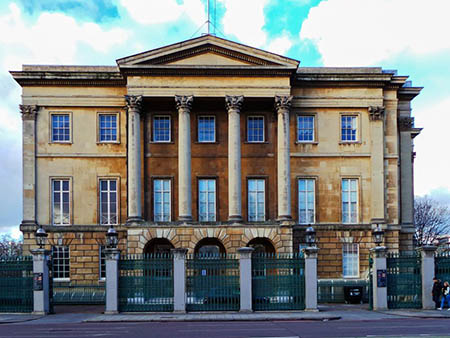
(Apsley House- Number One London).
Apsley House now stands in splendid isolation in the traffic. Once, when it was carriages that passed through the gate into London, this was the first stately house to be seen. After the Victory at Waterloo it was only appropriate that they would call this place “Number One London.” I walked up to the massive door and worked the ancient knob and lock. This was the real thing, unchanged for nearly two centuries. Inside there was gloom, and a strange hooded leather chair. It was where a servant dozed, on call to meet guests of the Duke at any hour of the day. There was a small placard advising me not to touch it. It was un-restored, unchanged by anything except time and decomposition since the last servant’s withered buttocks had occupied it. That was what I found in this house of the General of His Age. It was as though the owner had only stepped out. Somewhere in this pile of sandstone are boxes of shirts, crisply starched and banded with ribbons, ready in case the Duke returns.
There was an interpretive handset available in the gift shop and I took it. But it wasn’t really necessary. This was a place that is both regal and personal. It was the Duke’s house, his home and his castle all at once. The most celebrated man of his era, he entertained and lived a long and public life after his great victory.
The young Arthur Wellesley was born in Ireland in 1769, a minor noble of the Irish Ascendancy. In the usual manner of the day a Commission was purchased for him to have a second-son’s calling in the Army. He entered service in 1787 and had a career synergistic with that of his older brother Richard. Arthur’s regiment was posted to India in 1796, and he was there when Richard was appointed governor-general of India. Arthur was offered command of a division, which he commanded at the invasion of Mysore and in 1799 he was appointed governor of Seringapatam. His decade on the sub-continent taught him many valuable lessons in practical warfare, leading coalition forces. Napoleon was said to have remarked derisively on Wellesley’s time in India, the experience being unworthy of a Gentleman. That might be so, but Arthur was a valued counselor to his brother, advising him on political and military issues. When Richard was recalled to England, Arthur went with him and was knighted for his distinguished service.
Arthur won election to Parliament in 1806 and was elevated to Irish Secretary in 1807. But the hostile empire across the Channel had established the Continental System, which excluded imports from Britain or its colonies and chaos loomed. England had to do what it could within limited means. In 1808 Wellesley was sent to advise and support the Portuguese in their revolt against the French, much as Americans went out to Indochina for the same purpose. Wellesley did it better. The campaign on the Peninsula had nine
major engagements, and the Peninsula Medal on his red tunic displayed in the basement of Apsley House is the only one with all nine battle clasps.
Wellesley ultimately assumed command of the same sort of combined force he had lead in India, and the experience there stood him in good stead. He led British, Portuguese, and Spanish forces in the Peninsula, fusing the rugged ground, fierce local patriotism and the preoccupation of the Corsican with campaigns elsewhere on the continent. Wellesley drove the French north of the Pyrenees. Despite the grudging support he received from Whitehall, he pushed on into southern France and when Napoleon abdicated in 1814 he was at Toulouse. A hero.
Part of my admiration for the Iron Duke is derived from this dispatch from the field, which is perhaps folk legend, but better sums the contempt of the forward-deployed for those in the rear:
“General the Earl of Wellington, K.B.
Central Spain, August 1812
Gentlemen,
Whilst marching from Portugal to a position which commands the approach to
Madrid and the French forces, my officers have been diligently complying with
your requests which have been sent by H.M. ship from London to Lisbon and
thence by dispatch to our headquarters.
We have enumerated our saddles, bridles, tents and tent poles, and all manner
of sundry items for which His Majesty’s Government holds me accountable. I
have dispatched reports on the character, wit, and spleen of every officer.
Each item and every farthing has been accounted for, with two regrettable
exceptions for which I beg your indulgence.
Unfortunately the sum of one shilling and ninepence remains unaccounted for
in one infantry battalion’s petty cash and there has been a hideous confusion
as to the number of jars of raspberry jam issued to one cavalry regiment
during a sandstorm in western Spain. This reprehensible carelessness may be
related to the pressure of circumstance, since we are war with France, a fact
which may come as a bit of a surprise to you gentlemen in Whitehall.
This brings me to my present purpose, which is to request elucidation of my
instructions from His Majesty’s Government so that I may better understand
why I am dragging an army over these barren plains. I construe that perforce
it must be one of two alternative duties, as given below. I shall pursue
either one with the best of my ability, but I cannot do both:
1. To train an army of uniformed British clerks in Spain for the benefit of
the accountants and copy-boys in London or perchance.
2. To see to it that the forces of Napoleon are driven out of Spain.
I have the honor to be, &c.
Wellington”
I couldn’t find it in a book of his dispatches from Spain, but maybe it is true. It certainly sounds like The Duke.
Returning to England, he received many honors and was created duke of Wellington. He served for a short time as ambassador to Paris, and then succeeded Viscount Castlereagh at the peace conference in Vienna. There was a rumor of the time that the Duke had traveled to the Louvre in Paris “unhooking and taking down the pictures which Napoleon had accumulated from every corner of Europe.” The Duke actually sent them back to their rightful owners, though other rightful owners demurred, and insisted that the Duke retain ownership of those he had actually captured in the field.
Then came The Hundred Days. Napoleon left Elba and raised the Grand Armee again through levee en masse- a military draft on steroids. Wellington returned to the field and assumed command of the allied armies. The field of Waterloo was a desperate fight, one that Wellington himself called “the closest run thing you have seen.” I have a tintype engraving done years after, of Wellington extending his hand to the Prussian Marshall, Gebhard Leberecht von Blücher, for it was the appearance of the bewhiskered German and his troops that sealed the battle and made Wellington the man of the age.
Again lavishly honored, he returned home to take an active interest in politics and service to his class.
He had a healthy distrust of the common man, revered but never loved by his troops. Flogging was part of the discipline of the Royal Army. Wellington considered the values of the gentry to be that ordained by nature. He became the backbone of the Tory House of Lords throughout his long life and he was not content to live the pleasant life of a Lord’s backbencher. Instead he actively served in a variety of cabinet posts, as master general of the ordnance in 1819 and represented England at the Congress of Verona in 1822. He fell out with George Canning over what the Duke saw as overly liberal ways and he left the government when Canning became Prime Minister in 1827.
In 1828 Wellington reluctantly became prime minister himself, viewing it as a duty to class and Britain. He compromised some of his rigid principles- above all things the Duke was a pragmatic soldier and politician. He allowed the repeal of the Test Act and Corporation Act and the passage of the Catholic Emancipation bill. In so doing he alienated the rank-and-file Tories and his ministry fell in 1830.
All through the rest of his long life Wellington held the Waterloo dinner on the anniversary of the battle. First it was held in the dining room of Apsley house with his close lieutenants. Later it evolved to the London event of the year in the magnificent banquet hall he constructed on the park side of the residence.
They say that long after the battle that vanquished Napoleon the bacillus that he had unleashed continued to spread. It grew in England, rising to the movement that brought the Great Reform Act of 1832. Ludd and his Luddites, trashing machines that would eliminate weaving jobs in the cottages in the country, fighting the establishment of the knitting mills and the industrialization of the North. In that climate the Mob came to Number One London. The Duke’s wife had died. He was in mourning, and not displaying the candle in the window that the Mob demanded as a token to Reform. They would have looted the place, Napoleon’s swords, Gold Marshall’s baton, plate and china, the whole lot. But a servant went to the roof, and fired a blunderbuss to heaven and fired it again until the mob retreated.
Wellington was a Francophile. He is said to have had relationships with two of Napoleon’s mistresses, and certainly was a collector of other articles associated with the Corsican. He also continued his public service. Under Sir Robert Peel he was foreign secretary twice. In 1842 he was made commander in chief of the Royal Army for life. He died in 1852, thirty-seven years after his last military triumph. He is buried under a magnificent bronze martial memorial in St. Paul’s Cathedral. When the procession took him to his rest there they say a million people clogged the streets, saying that they would not see his like again.
I walked from the entry hall past a set of closed double doors on which was affixed the notice: “Private Apartment.” When the 7th Duke was killed serving with the Parachute Regiment during the war- and by that of course I mean the Second World War- the title fell to his uncle. The place was about down to wrack and ruin and there was no way he could keep up the city place and the country place. So he cut one of the historic deals with the Government. In exchange for deeding over the property to the Trust, he kept the private lawn in back and a nice apartment It looks like it is the entire third floor and the former Duke’s private museum on the ground floor. I assume they have to use the old servants stairs to reach the apartment. The Duke’s museum has been moved to the corner of the first floor.
The entire house is filled with treasure. It is one of the attics of the Empire that not been consigned to Portobello road. To the left off the entrance is the Museum. It is a ground floor room that contains the personal trophies of the duke. There are his Marshall’s batons, one from each of the Grand Alliance that brought down the little Corsican. The swords; the Duke’s and the one Napoleon carried that day in Belgium. There are objects of silver and gold of astonishing detail, ewers and shields and candelabra. From the walls hang the embroidered flags of the vanquished French, intended for display as Napoleon marched into a conquered Brussels.
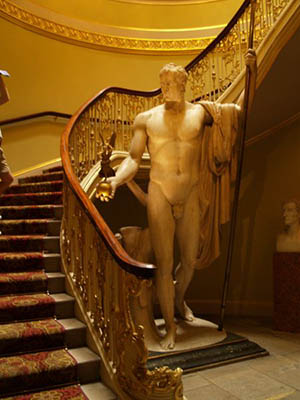
(Lager than life statue of Napoleon greets you at the door).
There is china and silver and air everywhere, mostly art captured and art commissioned of the men who won their version of the Great War. Walking to the circular stairs to the public salons and the living quarters on the third floor is the treasure of treasures. is the eleven foot tall stature of Napoleon, carved from a single block of Carrara marble stands at the base of the great curved staircase. Carved by Antonio Canova, it depicted Napoleon as Mars. It is nude, save for a cloak, and he clasps a winged nymph in his right hand. One of the wings passes close to the curved handrail of the steps, and the 8th Duke has said is was a real hazard to young men sliding down banisters. The British Government bought the statue from the Louvre for 6,000 francs in 1816 and the Prince Regent presented it to Wellington. The floors of Number One London had to be reinforced to bear the weight of the thing.
Napoleon won many more battles than the Duke of Wellington, but in the end it was winning percentage that counted. The Iron Duke was 100%. When he broke the proud Armee he guaranteed the British ascendancy for the rest of that century and bought the Pax Britannica that reigned for exactly one hundred years, 1815 right up to the gunshot that killed Archduke Franz Ferdinand in 1914.
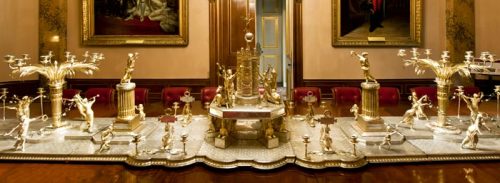
(The silver centerpiece donated by the people of Spain to The Duke).
The residence is both human scale and majestic. One of the chairs in the dining room has been left un-reupholstered to show what a leather chair 181 years old looks like. On display on the dining table is a silver centerpiece that is thirty feet long and has 1,000 sculptures. It has little silver plaques for all the victories on the peninsula, and a magnificent detailed confection of silver in the middle. It the single most magnificent thing I have ever seen, and you could touch it, or lunge at it, if you so desired. This is a residence, open to the public. Not a sterile well-secured structure or vault. A house. Made by a man to enjoy his life and his station.
That is all gone now. I saw a picture of how the place looked on hard times, fancy wallpaper falling in sheets like something out of Miss Haversham’s house in Great Expectations. During the Blitz, the fig leaf covering the Napoleon statue’s genitals was blown off by concussion. The sole remaining resident, an ancient lady of impeccable virtue, made it her first priority to have the strategic leaf restored. She was of an age that almost touched the Duke. To her, he was not a legend. For those that lived beyond it was something else. Giving the sandstone pile of Apsley House to the State was probably the only sensible answer
I don’t know how the current Duke gets on with it all, living out of the way of the tourists. The Blair administration had effectively ended the hereditary component of the House of Lords. Those Hereditary Peers of the Realm who have been permitted to stay have been limited to fifty in number, and they may not pass their seats on to their progeny, effectively ending a tradition going back to medieval times. Effectively, they are all now Life Peers, good only for a single life. The Labor Lords love it, although even the Trades Union Council peers have shown a distressing affection for the pomp and perquisites. Blair is a trip, just like his Millennium Wheel that now dominates the London skyline.
The Dukes of Wellington got a deal that pre-dates Her Majesty’s current government. They get to keep the apartment. Maybe that will change with a fickle electorate. But I imagine sometimes after closing, when there is no one else around, the double door to the private apartment can be opened and the Eighth Duke can wander the house to his content and dream of what was.
Perhaps he can even touch the talismans, and even play pretend. I can only wonder what the Ninth Duke can expect?
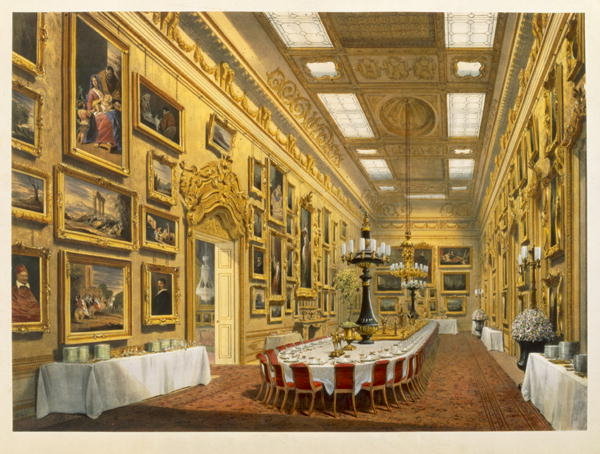
(The hall and table where the Waterloo Dinner was held).
Copyright 2014 Vic Socotra
www.vicsocotra.com
Twitter: @jayare303
Send a Salami
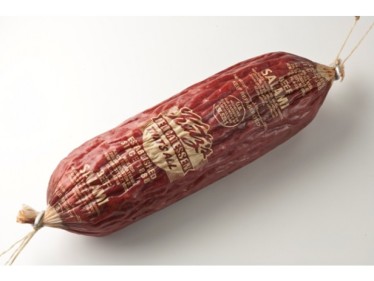
I am late on the story this morning, but I have a decent reason. I attended a small but very moving memorial at the cemetery for those veterans who gave the last full measure of devotion to their nation. Considering how almost universally dismal the recent events overseas have turned out, this ceremony with active and retired folks was held under deliriously blue skies and warm temperatures that belied the advancing snows of winter that are pummeling the upper midwest, and which will be here soon enough to strip the last gaily-colored leaves from the trees.
It was an honor to be in the company of other veterans, and I am still a little choked up. There was going to be a luncheon later for some of the participants, but I had things to do and rolled home a little after the ceremony at 1100 on the Eleventh Day of the Eleventh Month concluded. It is Veteran’s Day now, but that was the moment of the Armistice that concluded the bloodiest episode in Mankind’s bloody history in 1918, and the fields of France fell silent for the first time in four long bloody years, and remained that way for almost twenty-one years until the Panzers roared again.
I decided to not think about The Dead and instead contemplate lunch. You know how much I enjoy Willow, but I think I might wind up there later and would be tempted to have a glass of wine, and we know what happens when that starts so early in the day.
I wished there was a real restaurant of the caliber of the legendary Katz Deli in New York. That is the place where they shot the legendary scene in “When Harry Met Sally,” in which Meg Ryan simulated an orgasm to prove to Billy Chrystal that Women are indeed creative artists. After she finished the older lady at the next table looked up at the waiter and said: “I’ll have what she’s having.”
We did not eat at that precise table, but it was close enough. I heard a disturbing story on the radio the other day that the increase in beef prices has rendered the margins on their famous brisket and pastrami sandwiches so narrow that no one can really make a go of the deli business anymore, unless you have paid off the restaurant. Katz opened its doors in 1888 and has been creating the best sandwiches in New York, and hence the best in the world, since then.
We can step outside if you want to claim the Carnegie is better. It is in Midtown, anyway.
During World War II, the three sons of the Katz family were all serving their country in the armed forces, and the family tradition of sending food to their sons became the company slogan: “Send A Salami To Your Boy In The Army.”
And that’s just what they have done. I have the shirt with the logo on it from a magical trip to New York a while back. I bought one of the three-month-aged all-beef hard salami and ate it for a week- cold, sliced and fried, sandwiches, with a cheese platter and moutarde chaude. I can only imagine what a treat it would have been to hear the words over the ship’s loudspeaker reverberate with the most welcome words any sailor can hear: ‘COD on the Ball with 10,000 pounds of mail!”
And then get a real Katz’s salami, mailed from the lower East Side of New York. I would have been the most popular guy in the Ready Room, no question. At least for the fifteen minutes it was still there.
Many a soldier and sailor have had their morale buoyed by the arrival of a package from home containing something that did not taste vaguely like jet fuel. One day on Gonzo Station in the Indian Ocean Miss Piggy, the US-3 cargo jet brought us parcel mail, and I got a box from Great Aunt Eleanor, who lived in a sleepy little town in Florida called “Orlando” long before Disney’s Mouse showed up.
The box contained something that might, weeks before, have been brownies. They were no longer, and into the shit-can they went, but I thought kindly about Aunt Eleanor, and how she remembered the War, and her boys overseas. I wrote a letter to her- remember those? And told her she was the squadron Saint, and everyone loved the baked goods- I couldn’t really tell what they had been, so I figured a general description was worth it.
In the spirit of the day, and sending food to our forces overseas, a pal in Mexico sent me a suggestion for something quite delicious. She says it will take care of anyone all day and beyond. I think I might try to bake one this afternoon. I even have a boy overseas I can send it to. He might prefer the salami, but I think this would make it in better shape than Aunt Eleanor’s brownies.
It would be a change for him from the Sushi out in town, or the shit-on-a-shingle in the mess on the ship.
Here is a real blast from the past, from Marion Cunningham, via Baja California. It is War Cake:
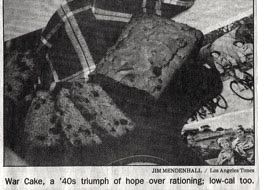
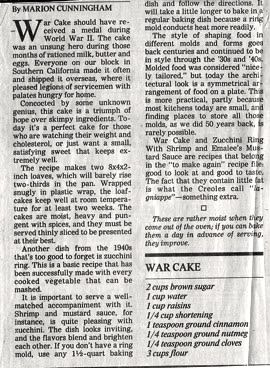

Copyright 2014 Vic Socotra and Marion Cunningham
www.vicsocotra.com
Twitter: @jayare303
Pastoral

Here at Refuge Farm, I got some things done that didn’t really need doing, and and started others that are going to be left unfinished by the time we get to beyond this chilly morning. The dawn was bright and the skies Virginia Blue as I swept up pine needles and surveyed the Fall debris that needs to be blown off the lawn and the gravel drive.
Do I have gas for the blower?
I think we scraped the first hard frost last night- it was crisp and chill and totally refreshing- though I am concerned what this portends in terms of another bawd-awful Polar Vortex winter.
My sole houseplant is happily inside- it was a casualty of the move to the farm- I left it out in the first hard frost a couple years ago and it was a blackened accusation of my negligence. I felt bad- it was an old friend and had been in all the four units and one farm where I have dwelt over the last dozen years. I had hoped that it would OK outside, but that clearly was a product of my disorganized thinking.
I approached the seeming plant corpse with care, didn’t dump it out, and instead moved it in and pruned off the dead stuff until a single green leaf remained. I thought the root system might still be intact, so I gave it dark mornings and bright afternoon sun in the west end of the great room, and it actually is coming back, though the process has been slow.
The plant and checking the mail are the two imperatives in getting down here- and both are necessary weekly functions. Like the distressing realization that I forgot to get more coffee beans as the afternoon lengthened, and the parallel jolt when I realized that it wasn’t almost the cocktail hour- the clocks had not been changed!

So off to town. I could have gone to the Big Box supermarket on the south end of town and saved a couple bucks, but coffee is one of those things I refuse to economize on. I was determined to get a bag or two of Dead Man’s Reach, the fine dark roast that really could raise the deceased. The Raven’s Nest coffee shop in town is where they sell it, and the place is a trip.
There are hipsters in Culpeper, I stood in line behind one, and in front of him there was a group of Ladies in their designer jeans, tall boots and leather coats, hair gathered back in ponytails for a little pre-holiday shopping on E. Davis street. Very seasonal, and it was very slow, as they ordered their low-fat soy lattes and other creations from the genial barrista.
The cakes and pies were tempting masses of sugar that I successfully resisted, though I am looking forward to a piece of rich pecan pie at least once this month.

The plant- I have no idea what kind it is- seems to be doing well. I really am a sentimental slob, I know, but it makes me happy.
That was quite the change from my savage attack on the nasty, evil, vines and bushes that were threatening to overwhelm the fence down in the lunging ring behind the east pasture. I had been meaning to get to the tangle all summer- a big branch had come down across the fence and trying to cut around it with the Turf Tiger almost got me impaled on the branches, and the voracious grasp of the vines and the startlingly rapid encroachment of the bushes and scrub trees needed attention. I traded one of the early football games Sunday afternoon for a frontal attack on the invaders, and was delighted with the improvement.

By the time I got the tools put away and cleaned up, I was famished. The wonderful pastries at Raven’s Nest got me antsy to try some seasonal baking, and you are well aware of my passion for cast-iron cooking. Coming back from town I stopped at the Minuteman Antiques Mall, a vast warehouse with hundreds of vendors (mostly unattended) supervised by a team of good ole gals.
I am always on the look-out for old cast-iron cookware. I read the other day that current technology is to pour the molten iron into sand molds, which lends the slightly dimpled surface of the pans. The old ones used hard molds that rendered a much smoother surface. It was a little more expensive, so I don’t mind finding old ones with a little surface rust I can fix and re-season to produce culinary magic.
I may get around to an appreciation of the popular myths of cast iron cooking one of these days- my pal in Utah send a provocative note about the topic yesterday- but I was looking around for something to go with stews and chili dishes as the temperatures plunge.
I wanted some carbs- craved them- after battling the encroaching underbrush. Melissa Clark of the New York Times came to the rescue. She is nuts over the “brown butter” aspect of the recipe- as I am. There is something nutty and good about it, and the food police have finally had to agree that there is absolutely nothing wrong with the dairy goodness. She uses maple syrup for the sweetness, but you can substitute Pond Hill Farms clover honey if you please. I prefer the product of Natasha’s three hive next door, but I get a special deal not available to regular consumers.
Get out that cast iron pan and get cooking! If you do not have one, let’s go look at the Minuteman Flea Market- it is the time of the year.
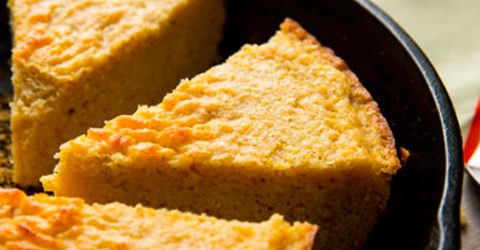
INGREDIENTS
12 tablespoons (1 1/2 sticks) unsalted butter (I like Challenge-brand)
½ cup maple syrup (or local honey)
2 ¼ cups buttermilk
3 large local eggs
1 ½ cups yellow cornmeal, fine or medium-coarse grind (Melissa prefers the fine for more taste, I like the slightly coarser for texture)
½ cup whole-wheat flour
½ cup all-purpose flour
1 ½ tablespoons baking powder
1 ½ teaspoons kosher or Baline Sea salt
½ teaspoon baking soda
PREPARATION
Heat oven to 375 degrees. On the stovetop, in a 11- or 12-inch skillet (ovenproof and preferably cast iron), melt the butter over medium heat. Cook, swirling pan to lightly coat sides and bottom, until the foam subsides and the butter turns a deep nut brown. (Watch carefully to see that it does not burn.)
Pour brown butter into a large bowl. (Do not wipe out the pan.) Whisk the maple syrup into the butter, then whisk in buttermilk. The mixture should be cool to the touch; if not, let cool before whisking in the eggs. Then whisk in the cornmeal, flours, baking powder, salt and baking soda.
If the skillet is no longer hot (cast iron retains heat longer than other metals), reheat it briefly on the stove for a few minutes. Scrape batter back into it. Bake until the top is golden brown and a toothpick inserted into it emerges clean, 30 to 40 minutes. Cool in the skillet for 10 minutes before slicing or you will be sorry.
We can re-engage on the passionate issue of whether to use soap in the clean-up of your cast iron pot in a future episode of The Pastoral Life. In the meantime, enjoy life in the country.
Copyright 2014 Vic Socotra; recipe Melissa Clark NY Times
www.vicsocotra.com
Twitter: @jayare303
Tales from The Goat Locker: The Apprentices
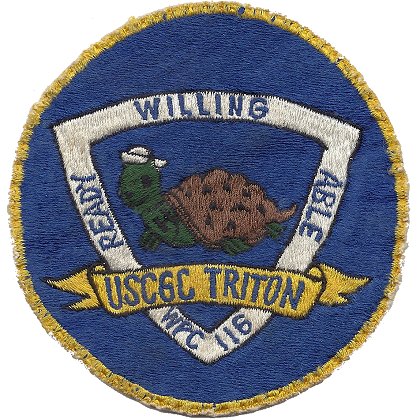
I talked to the LTJG via the miracle of Google Chat the other morning, and we discussed a couple clear differences between my Navy and his. It is a lot more correct these days, and not nearly as hung over as my class of hard-partying liberty hounds.
Of course, I was a couple years older than the norm in my Fleet days in WESTPAC. I had worked for a book publishing concern out of New York, stationed in exotic Detroit, before getting a touch of the wanderlust and shipping out for Aviation Officer Candidate School, and the tender treatment from Staff Sergeant Ronald C. Mace, USMC.
So, I was in my late twenties by the time I emerged from the pipeline and reported to the World Famous Vigilantes of VF-151, embarked in Ma Midway (CV-41) and had pretty much set all the bad habits I have worked hard to maintain ever since.
That wasn’t the case for most of the men- and is was an all-male fleet then- who composed the bulk of the crew. I have been having a back-and-forth with Boats, the retired Coastie Master Chief about the difference in eras and ages. He wrote me yesterday to explain some of the challenges that would not have occurred to a smart-ass college grad, and what he described is a system that brought young men into the safe-harbor of maturity.
As a society, we have a couple generations who have come of age after the draft was abolished in 1973, and we have seen the consequences of the impact of households that have no father to assist in the transition to adulthood.
“An after thought I’ve had about the difference in experience on liberty between myself as a painfully young non-rated sailor and “young” junior officers experience on liberty in foreign ports,” he began, and then he told me a story that was poignant and kind of sweet and sad at the same time. What he talked about was a system that doesn’t exist any more because society and the Services have changed. It might have helped some of the lost young men whose deaths are so prominently reported these days.
Boats described it this way: “As was not all that unusual in the 1960’s, I entered the Navy immediately after high school and I graduated young. I was 17 when I arrived at Great Lakes Naval Training Center. I spent the years between 17 and 22 transitioning from Seaman Recruit to Boatswain’s mate First class. Six pay grades in five years was aided by skipping E-2 after boot camp, my only “meritorious” promotion.
I was far from the only teem-ager in the fo’c’scle back then. On our first liberty in San Juan, the XO arranged for an escorted tour of the Island for a dirt-cheap price. He encouraged all of the teenaged non-rates to go on it, and he came along on the tour and spent the day with us.
The over-21 seamen and petty officers hit the dives and few of them made it more than a few blocks from the ship. Most spent a month’s worth of pay on day one. I learned a lot about foreign liberty that first out CONUS liberty.
I experimented a few times but basically decided that it was cheaper and more enjoyable to avoid the dives and sex clubs. I think I managed to avoid a lot of trouble that would have slowed down that lightening-fast ascension to First Class.


When I first reported aboard the Thetis-class Medium Endurance Cutter Triton (WMEC-116) down in Corpus Christi with post-patrol liberty in Tampico I noticed that the first Class Engineman that everyone called “Papa White” typically did something similar to what the XO did on the destroyer.
Not only was he there steering the teen-aged non-rates away from trouble on the beach at Tampico by arranging and encouraging economical and enjoyable outings, but he took about half the teen-aged liberty section home on Friday night. His wife served up hot dogs and fries. Then we usually watched a movie on TV, ate, and slept on the living room floor.
A typical Saturday was a softball game with some of the youth group from his big Presbyterian Church, lots of attractive but “decent” Presbyterian girls at the game, occasionally a girl’s game preceded or followed ours.
On Sunday morning we all went cheerfully to Church, including us Catholics and our one Jew. As a Catholic, used to a fast one-hour service the idea of spending the morning in different bible study groups, then a prayer service and barely getting out the church complex before noon was unusual but I have to say I actually enjoyed it.
Generally the Congregation accepted us as just a sort of another youth group and no body got too far out of line. After church, Mrs. White (they had no kids) made a big chicken dinner. About 1600 we started drifting back to the ship by liberty van, city bus, the rare non-rate’s car.
Sundown often found us fishing off the fan-tail. Liberty wasn’t very exciting but it was pleasant and a real break from the weekly routine.
The XO on TRITON had struck a deal with the local cops and a North Beach Bar where we could go and get a limited amount of beer and late-night Mexican food only a few blocks from the Buoy Depot gate.
A woman named “Millie” who must have been around sixty years old oversaw the place. If any of us had more than two beers in an hour or showed any signs of inebriation we’d be cut off. Make a fuss and “Aunt Millie” called the cops and you were unceremoniously dropped off at the Buoy Depot gate.
All things considered, the years between 17 and 20 and the transition from Seaman recruit to Boatswain’s mate Second was characterized by a lot of almost imperceptible mentoring by some senior officers and petty officers, who unlike BM-2 Morrison and BM-1 McElroy weren’t trying to teach me my rate. They were trying to teach me how to be an adult.
Of the six teen-aged non-rates on TRITON, two of us retired as Master Chief Boatswains mates. One became an officer and the other three left the service after four years and went to college.
The last I heard from them, they landed pretty decent jobs and had wives and families. I don’t think that I realized it until I was much older that while the teen-aged seamen were certainly exposed to the “perils of the sea,” we were actually pretty carefully protected and mentored about the perils of the beach, and we were mentored constantly by more than our rating coaches in areas ar beyond seamanship, navigation, gunnery and signaling. They were teaching us to be grown-ups.
What was most unusual was that the Navy Destroyer had this informal system going and I passed right from it to the system on TRITON. It was years before I realized how unusual the level of care and concern for the non-rates was on those two ships. This unusual and constructive atmosphere was not created by military fiat.
This is awfully politically incorrect to say; but I believe that my early life as a teen-aged sailor was graced simply by Christians who were doing what Christians do, and who happened to be older and senior to me.
Nothing could make a sailor’s apprenticeship physically safe, but the Christians I happened to have appointed over me kept the experience morally safe and constructively educational. My friends who spent the same years drinking and partying their way through LSU thought I’d been handed a raw deal. After my first cruise, I wouldn’t have traded places for anything. But I know I was very fortunate.
It is different today. Recruits tend to be over 21, and are often married of have had some college. But I think the nation is missing something with the great reduction of teen-aged naval apprentices. I think it would be a great experience if some of the off-duty care and nearly invisible “supervision” that I experienced could be institutionalized.
With all of the continuing education “distance learning” programs today why not skip that burdensome student loan, let Mom and Dad retire in peace and plenty and enlist with the dual goal of completing the apprenticeship to a rating and earning that degree while serving.
It might take six to eight years to do both. However, young people would leave with out debt, and highly employable. The lower and middle enlisted grades would gain a lot of stability and experience while still having enough movement to allow an encouraging rate of advancement.
I think we need to sell our military services as a great place to get a real education, not some place to “earn money for college”. The naval ratings are the last great “Master, Journeyman, Apprentice” system. Its very structured but structured around the great adventure of naval operations.
Our older new recruits today actually come from the structured learning/advancement system after some disappointments in the civilian post secondary educational system and job market. It seems a shame that so many young people between 17 and 22 have to waste so much time.
Unfortunately today a Muslim Imam will be welcomed into a public high school gladly to explain to the student body why they all now have to eat Halal food, while I would be viewed with utmost suspicion.
The naval apprenticeship program has been saving impressionable teen-agers since 1776 from the stupidity that has destroyed our nation.
Oh, and TRITON, my first Medium Endurance Cutter? She was laid down in 1933, and served on active service through my time aboard her. In 1967, she was sold as government surplus and converted into a twin-deck passenger excursion vessel for Circle Line Sightseeing in New York City. She is serving still.
Sometimes the old ways are the best, you know?”

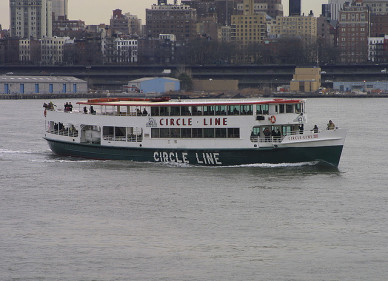
“Boats”!
Copyright 2014 Vic and Boats
www.vicsocotra.com
Twitter: @jayare303
Tales From the Goat Locker: Non-rates
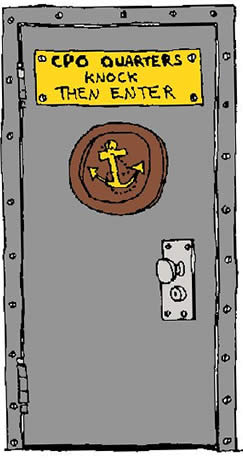
Vic, the stories about Sydney were Interesting, though the waters I cruised in my career were a little closer to home. You wrote about sea-stories yesterday. I have a few of those, too on the way to a career that culminated as a Master Chief Boatswain’s Mate, United States Coast Guard. I don’t mind your officer-centric approach- I suppose there is a need for you guys, but sea stories really are the province of the Goat Locker- the Chief’s Mess.
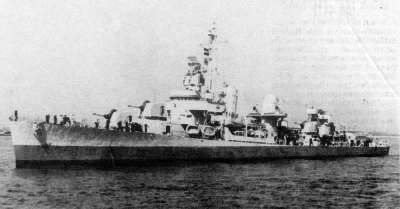
My first ship after Great Lakes RT was a Fletcher-class destroyer out of Mayport doing mostly Eastern Caribbean patrols off of Cuba, Haiti, and the Dominican Republic.
Being a 17-year-old E-3 (I picked up an extra grade out of boot camp for having graduated as honor man) I had little clue at the time why we were maintaining a naval presence there. I was more interested in perfecting my helmsmanship and convincing the BM-2 that despite my “gratis” status as a full seaman that I ought to be assigned more technical gigs like pointer or trainer on one of the mounts vice extra lookout, bow or stern hook on one of the launches, line handling instead of stand in ranks with the other teenaged SAs (E-2s) at special sea detail.
It’s really interesting now to see what that portion of the Atlantic Fleet was actually a part of. It was while on that first Navy ship that I met and saw the Coast Guard in action and met my first Coasties in person.
Comparing non-rated life, the Coasties didn’t seem to have to campaign for Boatswain mate-like assignments. Whatever they were willing to learn they were quickly assigned to. I was a two-year naval reservist on active duty. I went to visit the CG recruiters and learned that I could cross over by signing up for the CG regulars for a 4-year active duty contract.
But I had to get on a waiting list. I got on the waiting list and proceeded to agitate for a jump-up, arguing that I wasn’t a boot recruit and I’d save ’em $10,000 on boot camp. It took awhile but eventually reason or annoyance factor won out. I ended up on a much smaller CG ship patrolling the Campeche Flats off Yucatan on Piracy Suppression before anyone had even heard of piracy suppression patrols.
On reporting aboard, my billet included helmsman watch, gun crew and boat crew duties, and a spot in the landing/Boarding party. I also drew mess cooking, which sucked, but went with being non-rated.

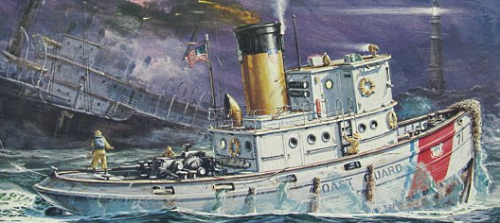
The maintenance on the old tug built in 1938 was intense but I got to use power tools, learned fancy rope work which covered a lot of ugly aged stuff on board, and gave the cutter a sort of “Yacht-like” feel.
On the USN destroyer, new non-rates did get to stand helm watch but most of our time was spent “soogeing”, sweeping down, painting in remote corners where it was more important to get the steel covered than to have the paint also present a decent appearance.
I often wonder if life for new Naval non-rates has improved any. I worked much harder in the Guard, but learned something new every day and after 3 months felt like a skilled craftsman even though I was non-rated.
On the destroyer, mostly I was bored until GQ was called or it was time for helm watch. Anyway thanks for the trip down memory lane and distant ports of call with the insight of history. It was nice to be a part of history, but my part was pretty boring.
Boats

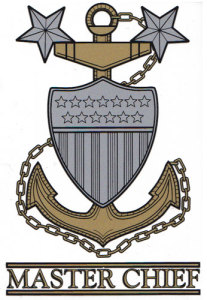
Copyright 2014 Vic and Boats
www.vicsocotra.com
Twitter: @jayare303
Flat Tops (Down Under)
My pal Marc had to chime in about Sydney- a town several colleagues waxed enthusiastic about. There is a reason for that, just as there is a reason the story today is late. This will address this. Marc recalls:
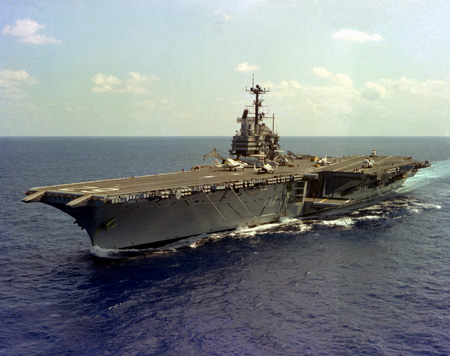
(USS Independence underway out of Japan, 1992).
“We took Indy-maru (CV-62) down to Sydney in 1992 for the 50th Anniversary of the Battle of the Coral Sea celebration after the adventure in the Persian Gulf and Desert Storm. The Pacific and Indian Oceans are big places – and OZ is a big country. It took us a couple of weeks to steam down to Sydney from Yoko as we had to head east past Guam before heading south.
I told you about my other experiences in Perth and this was the first port call in that great country that I was able to take my wife to, eschewing the considerable charms of Australian women that I had come to enjoy as a bachelor. Unlike the Europeans, the Australians have never forgotten the sacrifices of the US Navy that we endured to thwart the Japanese invasion of Port Moresby – the loss of the first Lady Lex (CV-2) and severe damage to the Yorktown (CV-5) and her miracle recovery over a weekend in Pearl which enabled her to lend the weight of her air wing to the decisive victory at Midway.

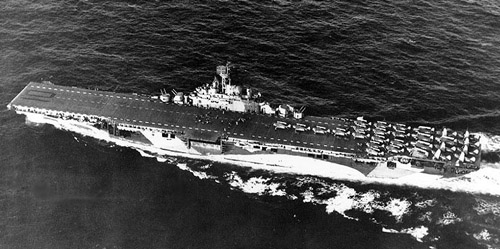
(USS Yorktown underway, 1943. Photo USN).
The Japs lost the services of their flat-tops Shinkaku and Zuikaku which deprived the Kido Butai of much of its striking power, ensuring relative parity of the fleets at that critical junction in the history of naval warfare, for which our beloved Midway Maru was named.
Imagine what that was like – Hornet (CV-12) had been sortied to conduct the Doolittle Raid on Tokyo, Frank Jack Fletcher had taken Lexington and Yorktown with him to the Coral Sea, and Enterprise (CV-6) got stuck with guarding the home islands, and Midway was brewing. I know that Mac Showers was there at Station HYPO, cracking the Jap codes and watching all of this unfold along with all of the Ultra and Magic intercepts coming into JICPOA and trying to sort it all out – wow. The power and fear of the carriers of that vintage and their impact was awesome.
It was there in Sydney Harbor that I scored my second stateroom qual, after achieving that a few months before during the final dependent’s day cruise on Midway before we went to Pearl to do the turnover. We actually did a practice strike on Midway during the transit where we played the role of the Japanese Navy and it was great fun to write up the scenario – of course, the good guys won.
Let’s get back to Sydney. My wife and I took the ferry on a nice day (albeit the Australian winter) over to a great seafood restaurant called Doyle’s which was on a promontory on the south side of Sydney Harbor, where we enjoyed a magnificent lunch of lobster and other wonderful creations from the kitchen of Alice Doyle, the daughter of the founder of that incredible place. She served us herself, and I still have her autographed cookbook – a great and gracious lady. after lunch, we took the ferry ride further to Bondi Beach where we marveled at the parrots and parakeets that were flying between the trees and outdoor bars. I thought then that Australia was what America could have been.
To lure a carrier down to Sydney for the 50th Anniversary, the Australians had proffered a massive ball – more than 5000 people, along with their Prime Minister and then SECDEF Dick Cheney as guest speakers. I had my mess dress that I had commissioned from a tailor in Korea, Mr. Lim’s, outside the gate in Osan.
My wife had no dress but we found one that could be quickly tailored to her proportions in a small boutique down the street from the Marriott where we were staying. It was black and stunning, a lot like the sleeveless and shoulder strap-less one that Rita Hayworth wore in her signature film “Gilda” where she performed her famous strip tease.
When asked what had held the dress up, Rita had told reporters “two things” – my wife (still) lacks nothing in that category. She’s a tall, blonde Swedish heritage ballet dancer, and still dances and teaches dance classes almost every day, wherever we have been, be it Camp Zama, Atsugi, Newport, San Diego, DC, Key West, and Annapolis, which is nice. She is a beautiful and talented dancer and once I had seen her on the stage, I could not take my eyes off of her. She’s that damn good.
The deal with the Aussies was that we would host the military happy hour on the Indy and then take buses to the main event. So there we were on the hangar deck of Indy, having drinks at the reception. it was lively at first but I started to get a little bored so asked my wife if she would like to see my stateroom. She gave me at first a “why the hell would I want to do that?” look until she realized my bad intent. Then she smiled. I took her by the hand and led her forward to an accom ladder up forward that led to the 0-2 level.
The deal you have with your roommate is that, when you were “entertaining a young lady in your stateroom” that you would hang an empty coat hanger on the door handle outside as a signal. My roommate at that time is now the current superintendent of the Naval Academy. His wife, Linda, was not in town. I hung the coat hanger, and was in like Flint.
We descended about 30 minutes later and caught one of he buses to the party. And what a party it was. The Aussies know how to put on a show and there was not a dry eye there after all of the speakers were done. Freaking amazing.

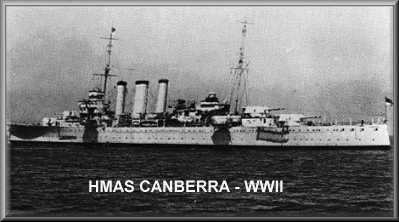
The ball itself started out with a memorial ceremony during which the Aussies rolled out the bell salvaged from the HMAS Canberra (sunk in the Sunda Strait) and used it to toll for the dead. There was a Glenn Miller-type tribute band that played ‘30s and ‘40s Big Band music. The multiple dance floors were crowded and almost impossible to mount – we found a place to swing in one of the aisles and soon were joined by others who didn’t want to attempt the dance floors. With so many people moving energetically powered by copious amounts of alcohol, the ball room rapidly heated up and people were sweating profusely, despite the fact that outside it was fall Down Under.
Cheney was accompanied by his wife, Dr. Lynn and the Aussies almost made her a bigger deal than him. He gave a good address, but we bailed early due to the crowds and grabbed a cab back to our hotel.
When we left Sydney, we went further south to the Tasman Channel (sorry boys, no Hobart for you) and then steamed the length of Australia past Perth and up towards Diego Garcia and our on-station date in the Persian Gulf. I looked at it on a chart and it was something like 14,000 nm, more than half way around the world.
When you remember what we used to carry around in the magazines, carriers were pretty awesome in a Dr. Strangelove kind of way.
Sydney lives on in our memory. It is a wonderful city in a wonderful country, and a wonderful people. Way back when, they know we Navy guys moved heaven and earth to protect their way and enjoyment of life and they will never forget it. In many ways, we are closer to them than the Brits or Canadians.
And Mac Showers, our career mentor and National Treasure got to see it all, and then some.
There are more stories in the naked city. Stay tuned.”
Copyright 2014 Vic and Marc
www.vicsocotra.com
twitter: @jayare303
